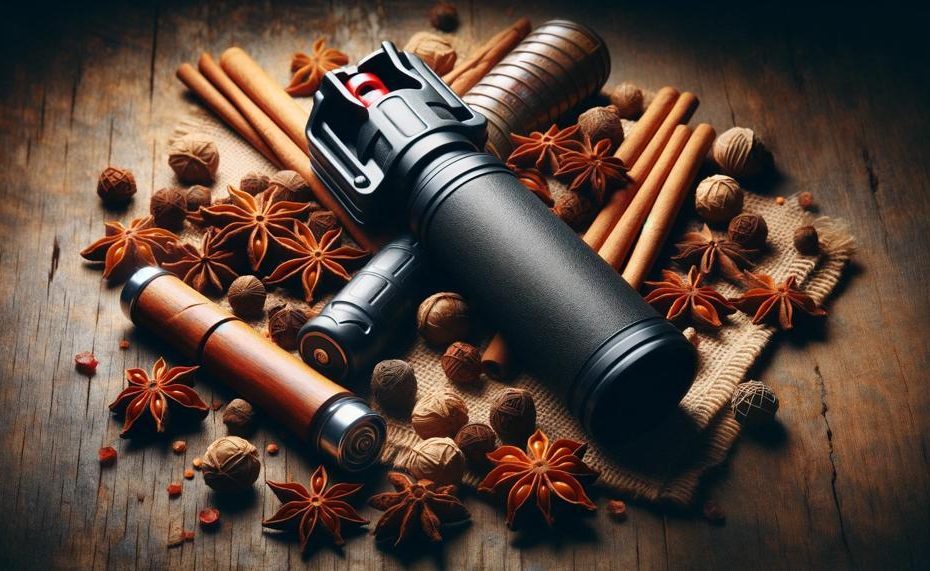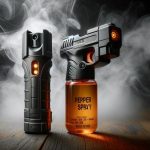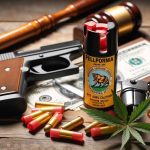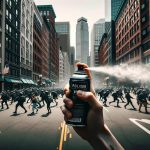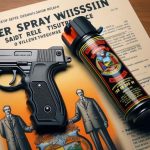Self-defense is a priority in today’s world, where personal safety can never be taken for granted. Among the plethora of options available to keep oneself secure, two stand out: mace and pepper spray. Although these terms are often used interchangeably in casual conversation, they are not identical twins in the world of personal defense. In fact, understanding the nuances between mace and pepper spray could be crucial in a threatening situation.
In this blog post, we’ll dissect the differences between these two popular self-defense sprays to clear up any confusion you might have. Our goal is to empower you with knowledge so that, should the need arise, you can make an informed decision about which one to carry in your pocket or purse.
So, is mace and pepper spray the same?
Mace is a brand of pepper spray. However, not all pepper sprays are Mace.
Mace contains the chemical chloroacetophenone, while pepper spray contains capsaicin. Mace is made with oil containing capsaicin, which is combined with other oils and chemicals to create a spray that can be used as a fog or stream.
Pepper spray is generally considered to be more effective than mace as a self-defense tool. It’s more potent and has a longer-lasting effect.
By the end of this post, you’ll have a clearer understanding of each product’s characteristics, helping you make a more informed choice for your self-defense needs. So, let’s dive into the specifics and arm you with knowledge that’s as powerful as the sprays we’re discussing.
Contents
- 1 Is Mace And Pepper Spray The Same?
- 2 Chemical Composition of Mace and Pepper Spray
- 3 Potency Comparison: Mace vs. Pepper Spray
- 4 Legalities of Using Mace and Pepper Spray
- 5 Effectiveness as Self Defense Tools
- 6 Proper Training for Using Mace and Pepper Spray
- 7 Tips for Safely Carrying and Using Mace and Pepper Spray
- 8 Conclusion
Is Mace And Pepper Spray The Same?
Mace and pepper spray are terms frequently conflated, yet they differ in composition and effects. Mace, originally a brand name, often refers to self-defense sprays that include tear gas chemicals, while pepper spray is grounded in oleoresin capsicum (OC), derived from fiery chilies. Here’s how they stack up:
| Aspect | Mace (Brand) | Pepper Spray |
|---|---|---|
| Active Ingredient | CN or CS tear gas | Oleoresin Capsicum (OC) |
| Effect on Assailant | Causes tearing and stinging | Induces intense burning, coughing, and temporary blindness |
| Potency | Generally less potent than OC | Can be up to 100 times more potent than tear gas |
| Washability | Easier to wash off due to volatile base | Hard to wash off, prolonging the incapacitation |
| Legality | Varies by location; check local laws | Generally legal with some state restrictions; verify locally |
In essence, while Mace incapacitates by irritation, pepper spray outperforms with its fiery formula, causing a more intense and lasting debilitation. Both are legal with caveats, and their use is governed by local laws. As self-defense tools, they’re potent, but mastery in their application is key.
Chemical Composition of Mace and Pepper Spray
The primary chemical components that render mace and pepper spray potent for self-defense are Phenacyl Chloride (CN) in mace and Oleoresin Capsicum (OC) in pepper spray.
Below is a table detailing these active ingredients and their role in self-defense effectiveness:
| Product | Main Chemical Component | Effect on Attacker |
| Mace (Tear Gas) | Phenacyl Chloride (CN) | Irritation to eyes and respiratory system, causing tearing and intense discomfort |
| Pepper Spray | Oleoresin Capsicum (OC) | Intense burning sensation, temporary blindness, difficulty in breathing, and pain |
Mace’s active ingredient, CN, is a lachrymatory agent, which means it specifically targets the mucous membranes to cause tearing and pain, whereas OC, the active component in pepper spray, is an inflammatory agent derived from capsaicin in hot peppers.
In addition to these, some pepper sprays include an invisible UV dye to mark the assailant for later identification by law enforcement, and certain formulations might also integrate a small amount of tear gas to heighten their incapacitating effects.
Potency Comparison: Mace vs. Pepper Spray
When comparing the potency of mace and pepper spray, the primary distinction lies in their active components and their corresponding effects:
| Aspect | Mace | Pepper Spray |
|---|---|---|
| Active Ingredient | Combination of OC, CN (tear gas), and UV dye | Capsaicinoids derived from chili peppers (OC) |
| Immediate Effect | Tears, pain, and disorientation | Intense burning sensation, inflammation, and temporary blindness |
| Target | Eyes, respiratory system | Eyes, skin, and respiratory system |
| Legality | Regulated, not legal in all areas | More widely legal with fewer restrictions |
| Deterrent Against Animals | Less common | Often used effectively |
| Identification | UV dye for suspect marking | Some variants include UV dye |
| Recommended Use | Self-defense against humans | Self-defense against humans and animals |
Pepper spray is generally considered more potent due to its high concentration of oleoresin capsicum (OC), which is an inflammatory agent, causing immediate and intense burning sensations. On the flip side, mace, being a concoction that includes tear gas, can cause severe disorientation and tears but might not have the same immediate incapacitating effect as pepper spray.
In terms of legality, pepper spray is more commonly allowed for self-defense purposes and is less restricted than mace in many regions. It’s pivotal to check local regulations to ensure compliance with the law.
Both mace and pepper spray can be instrumental in fending off an assailant, but due to its potency and broader legal acceptance, pepper spray is often the go-to choice for personal safety. Whichever you opt for, make certain it’s a fit for your needs and that you’re clued up on its use.
Legalities of Using Mace and Pepper Spray
Carrying mace or pepper spray for self-defense is generally legal, yet it hinges on the laws unique to each state in the U.S. The nuances between mace—a specific chemical irritant—and pepper spray, which is based on oleoresin capsicum, are crucial when considering their legal statuses.
State-by-State Variations
| State | Legal to Carry | Additional Notes |
|---|---|---|
| California | Yes | Permit required for concentrations over 2.5% |
| New York | Yes | Only for self-defense; must be purchased in state |
| Texas | Yes | No permit required, but size restrictions apply |
Responsible Use and Restrictions
While most states permit carrying these products for self-defense, the responsibility lies with the carrier to use them justifiably. Improper use could lead to assault charges. Moreover, certain locations, such as schools or public transport, may enforce a ban on these items.
Federal Regulations
Regarding air travel, both the FAA and TSA set strict guidelines prohibiting self-defense sprays on commercial flights or limiting the size and concentration allowed in checked baggage.
Stay Informed
It’s paramount to stay up-to-date with your state’s laws and federal regulations. Misuse or ignorance can lead to dire legal repercussions. Always consult local law enforcement or legal resources to confirm compliance with the laws.
In a nutshell, mace and pepper spray are generally legal for self-defense in the U.S., but the devil’s in the details.
Effectiveness as Self Defense Tools
Mace and pepper spray stand as vigilant sentinels in the realm of self-protection. They are not identical twins in the arsenal of defense, though they share a kinship in purpose. Let’s cut through the fog and shine a light on their effectiveness.
Mace: The Original Guardian
Mace, often mistaken as a mere synonym for pepper spray, is actually a brand that initially harnessed the incapacitating properties of tear gas (CS gas). It’s a chemical cocktail that irritates to the point of incapacitation but isn’t the same as its peppery counterpart.
Pepper Spray: The Fiery Shield
Pepper spray, on the other hand, is the general term for sprays containing oleoresin capsicum (OC), the fiery essence extracted from chilli peppers. This natural substance is the bread and butter of pepper sprays, causing an inferno of pain and temporary visual theft to wrongdoers.
Head-to-Head: The Effectiveness Standoff
When pitted against one another, which of these vigilant protectors holds the upper hand? The table below illustrates their potency:
| Self Defense Tool | Effectiveness Rate | Primary Reaction Induced |
| Mace (Tear Gas) | 60% | Irritation to eyes, difficulty breathing |
| Pepper Spray (OC Spray) | 90% | Intense burning, temporary blindness, inflammation |
The Wind’s Whims and Other Quirks
It’s worth noting that effectiveness can be swayed by the wind’s direction, the distance between you and the aggressor, and the individual’s tolerance for pain. Savvy defenders must be adept at using these tools, as improper use could reduce their might.
Training: The Key to Mastery
Proper training is the linchpin of effectiveness. Understanding the mechanics of your chosen defense can mean the difference between escape and entanglement. Select a reputable brand and keep an eagle eye on the expiration date to maintain the potency of your shield.
In essence, both mace and pepper spray can be formidable allies in the skirmish against aggression. With a 90% success rate, pepper spray reigns supreme in the realm of personal defense, casting a wider net of incapacitation. Mace, while slightly less daunting, still offers a robust 60% effectiveness rate. Both demand respect, preparation, and a steady hand.
Remember, these tools are a piece of the puzzle in the grand scheme of personal safety.
Proper Training for Using Mace and Pepper Spray
To wield mace or pepper spray effectively in self-defense, one must grasp the essentials of their operation and application.
| Training Element | Description | Benefit |
| Legal Knowledge | Research and comply with local regulations concerning defensive spray usage. | Avoid legal trouble; use sprays lawfully. |
| Spray Types | Understand the difference between mace and pepper spray. | Make an informed choice for self-defense needs. |
| Technique | Learn the correct handling and aiming methods. | Maximize effectiveness in deterring an attacker. |
| Practice | Conduct regular training sessions with your spray. | Develop confidence and proficiency in use. |
| Self-Defense Class | Consider additional self-defense instruction. | Enhance overall personal security skills. |
| Risk Comprehension | Be mindful of the potential effects on oneself and others. | Ensure safe and effective use when necessary. |
In essence, wielding mace or pepper spray isn’t just about having it at your fingertips; it’s about savvy preparation and the smarts to use it wisely.
Tips for Safely Carrying and Using Mace and Pepper Spray
To safely carry and use mace or pepper spray for self-defence, follow these guidelines:
Legal Awareness
Understand the laws in your location regarding possession and use of mace and pepper spray. Regulations can vary, so it’s essential to stay informed to avoid legal trouble.
Product Selection
Choose a product based on size, strength, and user-friendliness. Look for a high OC concentration for efficacy, and consider the spray range and mechanism for quick deployment.
Handling Know-How
Get acquainted with your mace or pepper spray. Practice aiming and deploying to ensure you can act swiftly and accurately in an emergency.
Accessibility
Keep your self-defence tool within easy reach. Attach it to your keychain or place it in a consistent spot in your bag for immediate access when needed.
Wind Direction
Be mindful of wind when deploying the spray to prevent blowback, which could incapacitate you instead of the assailant.
Targeting
Aim directly at the attacker’s face, prioritising the eyes and nose, to maximise the spray’s incapacitating effects.
Last Resort
Use mace or pepper spray only in dire situations. Attempt to de-escalate or escape before resorting to self-defence tools.
Post-Use Action
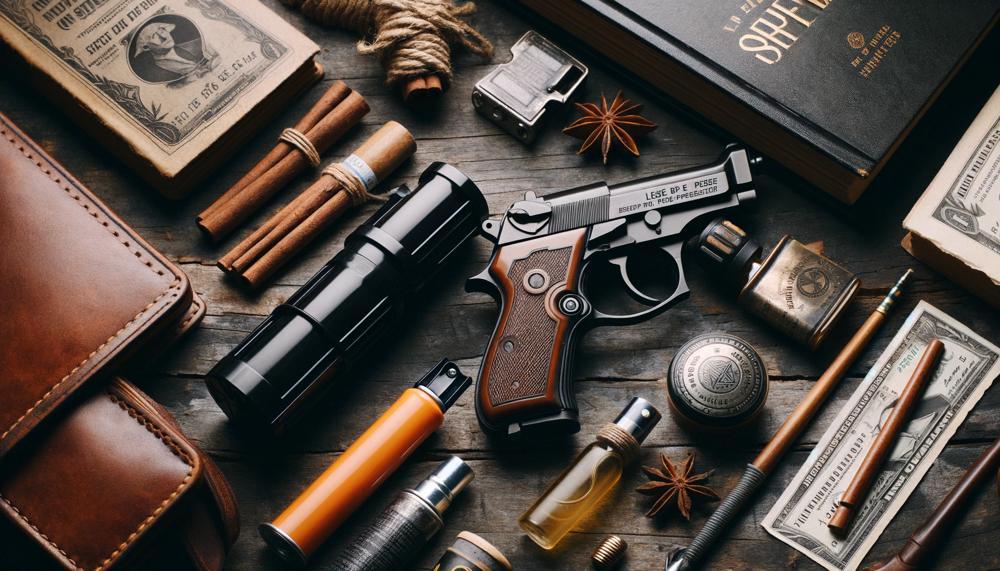
If you use mace or pepper spray, immediately wash affected areas and seek medical help if necessary to mitigate the effects.
Conclusion
In summary, while mace and pepper spray are both necessary weapons for self-defense, they are not interchangeable.
Unlike pepper spray, mace is less powerful and easier to remove from clothing than tear gas, which was originally the only brand name associated with it. However, the oleoresin capsicum (OC) used to make pepper spray has a stronger, longer-lasting impact that may result in severe burning, coughing, and temporary blindness.
Because of these variations in intensity and chemical makeup, pepper spray is often more effective for personal defense. Legal limits apply to both sprays and differ by state, so it’s important to keep up with local regulations.
Pepper spray is very effective as it often renders attackers unconscious. Users must, however, take into account other variables including the aggressor’s tolerance level and the direction of the wind.
You may increase your safety and make sure you are within the law by being aware of the distinctions between pepper spray and mace, as this article explains.
